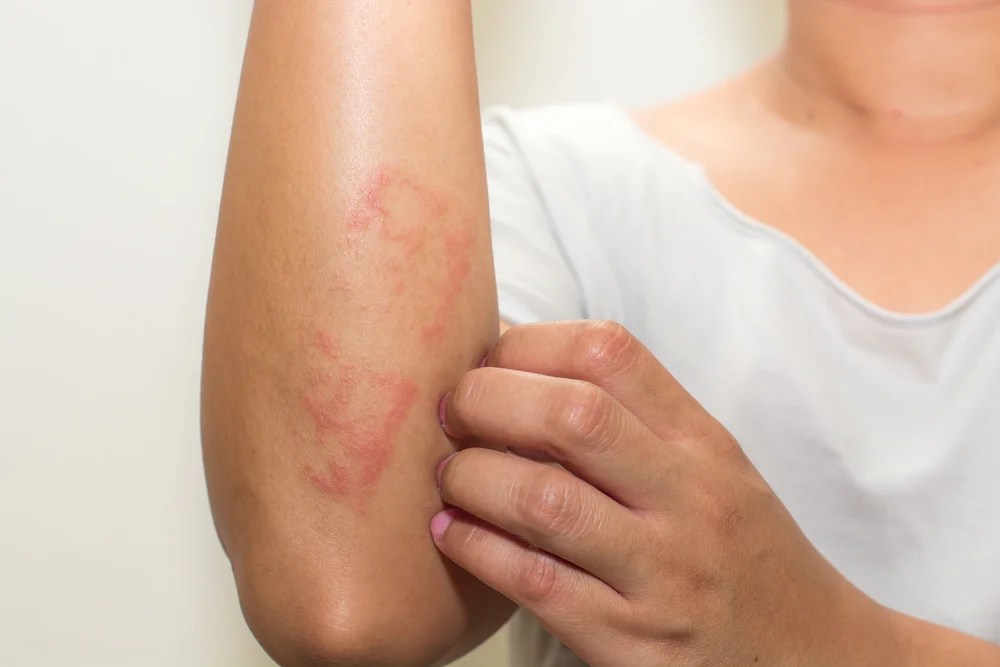- Scaly skin presents itself in a variety of shapes, sizes, and locations, and is frequently associated with itching, burning or soreness.
- Most types of scaly skin may be easily identified and treated with over-the-counter products and skin care routines.
- More severe types of scaly skin may require diagnosis and treatment from a dermatologist.
Dry, scaly patches of skin—especially on the face, hands, and legs—can be uncomfortable and embarrassing. But it is helpful to know that the majority of conditions that cause scaly skin are not contagious, and that in most cases this common concern can be effectively addressed.
Why Is My Skin Scaly?
There are many possible causes, ranging from simple dryness to more complicated dermatological conditions. These are some of the most common conditions associated with scaly skin:
- Dry skin
- Atopic dermatitis (also called eczema)
- Psoriasis
- Ichthyosis vulgaris
- Seborrheic dermatitis
- Actinic keratosis (also called solar keratosis)
- Skin infections or infestations (such as scabies)
Dry Skin
The outer layer of your skin is composed of a mixture of dead skin cells and natural oils that help maintain moisture. Every day, your skin naturally sheds about 30,000 to 40,000 dead skin cells, a process you would likely not notice.
If there is skin damage from sources such as the sun, chemicals, medications or certain health conditions, this process of skin cell turnover can be disrupted, leading to scaly skin.
You can protect your skin from damage and treat simple dry skin with the application of a daily moisturizer. You can also apply sunscreen whenever your skin will be exposed to the sun or while taking medications (such as certain antibiotics) that can cause your skin to be more sensitive to sunburn.
Eczema or Atopic Dermatitis
Eczema, also known as atopic dermatitis, is a chronic skin condition that more commonly affects children. Although there is no known cure, symptoms can be controlled.
Symptoms
- Dry, scaly, and/or chapped skin
- Itching that may worsen at night
- Red, brown or gray patches of skin that may appear anywhere on the body but are more common on the hands or face
- Skin that cracks, blisters, and/or bleeds
Causes
- Environmental factors – exposure to water, wool, perfumes, soaps, chemicals or smoke
- Genetic factors – family history of allergies, asthma or eczema
Prevention
- Moisturize at least twice a day
- Avoid the triggers that irritate your skin
- Take shorter baths or showers using warm rather than hot water and pat the skin dry
- Use mild soaps and avoid antibacterial soap or heavily perfumed soap
Treatments
- Topical corticosteroid creams or ointments – available in lower strengths over-the-counter or higher strengths with a prescription, such as hydrocortisone
- Oral corticosteroids (prescription only) such as prednisone for severe cases of eczema
- Topical tacrolimus and pimecrolimus (prescription only), which help to modify the body’s immune response to potential triggers
- Topical or oral antibiotics (prescription only) if an infection is also present
- Oral antihistamines (over-the-counter) such as cetirizine, fexofenadine or diphenhydramine to help reduce itching
- Light therapy
Psoriasis
Psoriasis is a chronic immune condition. The skin cells receive faulty signals, causing them to grow too rapidly. The skin cells then build up on the surface of the skin, leading to the formation of patches.
Types and Symptoms
There are five main types of psoriasis, each with its specific symptoms and appearance.
1. Plaque psoriasis or psoriasis vulgaris:
- Skin is characterized by plaques (raised, red patches of skin) and scales (a silvery or white coating that may cover plaques), and may be itchy
- Patches can appear anywhere on the body but are most often found on the knees, elbows, lower back, and scalp
- Scratching may cause plaques to thicken
- Symptoms may be accompanied by nail problems (pitting, crumbling, falling off)
2. Guttate psoriasis:
- Small, salmon-pink spots develop with fine scales anywhere on the skin, but are most common on the trunk, arms, and legs
- May appear following plaque psoriasis or an infection such as strep throat
3. Pustular psoriasis:
- Skin appears red and swollen and is marked by pus-filled bumps, which are often itchy or sore, and appear most often on the palms of the hands or soles of the feet
- Systemic symptoms such as fever, chills, and loss of appetite may be present
- Pus-filled bumps may leave behind brown, crusty scales on the skin after healing
4. Inverse psoriasis or flexural psoriasis:
- Skin is sore and appears smooth, red, and raw
- Develops in the folds of skin, such as the armpits, groin, genitals, buttocks or under the breasts
5. Erythrodermic psoriasis or exfoliative psoriasis:
- Skin appears burned; most of the body turns bright red
- Skin may be itchy and/or painful
- Body temperature cannot be maintained
- Skin sheds over a large area (considered a medical emergency—go to the hospital)
Treatments
Psoriasis is a chronic condition that cannot be cured. If you are experiencing any of the above symptoms of psoriasis, you should be evaluated by a dermatologist.
Following diagnosis, a dermatologist can tell you about the many prescription treatment options available to manage your condition.
Ichthyosis Vulgaris or Fish Scale Disease
Ichthyosis is a collection of skin disorders that are often inherited and begin during childhood. It can cause skin cells to build up, creating thick, dry patches that resemble fish scales.
Ichthyosis vulgaris is the most common form of the disease, occurring in 95% of cases. It presents most often during childhood; when it does in adults, it usually results from a health condition or certain medications.
Conditions Associated with Ichthyosis Vulgaris
- Kidney failure (long term)
- Cancer
- HIV
- Sarcoidosis
Medication Associated with Ichthyosis Vulgaris
- Cimetidine
- Clofazimine
- Nicotinic acid (a B vitamin)
Treatments
- Soaking in a warm bath to soften scales
- Frequent application of moisturizers that contain active ingredients such as urea or lactic acid, especially after bathing
- Applying petroleum jelly to deep cracks to promote healing
Seborrheic Dermatitis
Seborrheic dermatitis is the most common cause of dandruff. White or yellow scaly or flaky skin appears on the scalp, eyebrows, ears or nose. These patches of skin may be accompanied by an itching or burning sensation and the affected areas may be oily.
Causes
The causes of this condition are not completely understood. Researchers believe genetics, stress, and climate are responsible. Although there is a suspected relationship between seborrheic dermatitis and yeast that normally lives on the skin, scientists feel certain this condition does not result from poor hygiene or an allergic reaction.
The following medical conditions may predispose a person to develop seborrheic dermatitis:
- HIV
- Other skin conditions, such as acne, rosacea or psoriasis
- Parkinson’s disease
- Epilepsy
- Mental health disorders, such as depression or eating disorders
- Alcoholism
Treatments
The primary treatment used for seborrheic dermatitis is dandruff shampoo. These shampoos may contain a number of different active ingredients such as ketoconazole, coal tar, and salicylic acid.
Dandruff shampoos may be used on any area of the skin affected by seborrheic dermatitis.
Actinic or Solar Keratosis
An actinic keratosis (plural – actinic keratoses) is a rough, dry, scaly patch of skin that forms in response to severe sun damage or UV exposure in a tanning bed.
If you have one actinic keratosis, you are more likely to develop additional actinic keratoses during your lifetime. They are considered precancerous and require treatment by a dermatologist to prevent progression to a skin cancer called squamous cell carcinoma.
Skin Infections or Infestations
Skin can be infected by a wide variety of bacteria, viruses or fungi. Symptoms can range from mild to severe:
- Bacterial infections – organisms enter the skin through a hair follicle, an insect bite or a cut; symptoms begin as small red bumps that slowly increase in size
- Viral skin infections – such as measles or chickenpox cause a mild to severe rash and fever
- Fungal infections – usually develop in moist areas of the body such as the feet or underarms; some are contagious but aren’t life-threatening
- Parasitic skin infections – tiny insects or organisms burrow underneath the skins, lay eggs and cause a burning itching rash on skin—bed bugs and scabies fall into this category
Treatments
Mild infections may be treatable with over-the-counter medications but most require medical attention in the form of topical or oral antibiotics.
It is important to know that some infections can be contagious and some can spread to internal organs.
When Should I Consult with a Dermatologist?
As you can see from the information presented here, there are a wide variety of skin conditions associated with the appearance of scaly skin.
If your condition is severe or fails to respond to over-the-counter treatments, you should consult with a dermatologist. He or she will be able to identify the source of your scaly skin and prescribe a treatment regimen that works for you.









